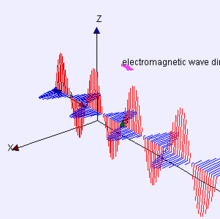I'm guessing you don't understand how current can flow if there is no complete circuit. Let's take a simple quarter-wave dipole as an example:

simulate this circuit – Schematic created using CircuitLab
How can any current flow, since there is no complete circuit from "-" to "+" of V1?
Consider this: relative to the speed at which the waves in the electromagnetic fields propagate, the dipole is long. It's true that current can't flow, but it doesn't know that until it gets to the end of the wire. As the current approaches the end of the wire but has no place to go, the charges pile up until they are pushed back in the other direction. By the time it's back, it's travelled \$\lambda/2\$ or experienced a \$180^\circ\$ phase shift. The voltage at V1 has also changed by this point, and so the current is constructively adding to the new currents being produced by V1. If it were not for some of this energy being lost as radiation, the energy in this antenna would grow without bound.
Why the energy radiates is complicated. The long answer is "Maxwell's equations". If you don't want to understand all the gritty details of that math, then here's a simple, incomplete understanding: the current in an antenna is associated with a magnetic field, and the voltage is associated with an electric field. An antenna is an arrangement such that at some distance away from the antenna (the far field) these two fields are mutually perpendicular and in phase, and what you get is a self-propagating wave like this:

Red is the electric (E) field, and blue is the magnetic (B) field. This is the sort of wave that would be emitted by a dipole aligned with the Z axis.
Antennas are reciprocal - they transmit and receive equally well (or poorly).
The reason it's important to tune a transmit antenna is because a mistuned antenna, by reflecting power, can destroy the transmitter output stage.
Tuning a receive antenna is much less important, compared to that!
Most receive antenna tuning is frequency sensitive, in fact in the crystal set days, the antenna was often part of the first tuned circuit, and re-tuned for each new station.
With a broadband antenna, there's really not much point making such adjustments.
However you can improve reception by:
if the received signal is weak, increase its height, or use a larger antenna better suited to that waveband.
if it's strong but contains interference, use a directional antenna to reduce the interference - or add a tuned circuit to reject the interfering frequency.
and so on.
These can make big differences in reception. If we knew what you are specifically interested in receiving, you may get more specific answers.


Best Answer
For reference, check out books by Balanis. They are THE reference on antenna design/theory.
This is a very good question and is key to fundamental EE principles.
To help visualize this, let's picture a quarter wave center-fed dipole antenna, which resembles a 'T' shape. When an incident electromagnetic wave of the same frequency at which the antenna is resonant, there is a standing wave generated at either end of the "T". This is generated because the charges generated by the incident wave on the antenna are not continuous along the antenna. So in theory you could take a voltmeter with both probes touching the same end of the antenna and gradually move one probe to the other end, and you will see a difference in voltage.
If you take a look at the book Electromagnetics Explained, it will show this distribution and explain (fairly well) the linkage between Maxwell's Equations and a very basic but accurate idiom on why the charges behave the way they do.
I know this is a somewhat vague answer, but a simple forum post like this doesn't do justice to really explain the interaction of EM waves and their behavior.